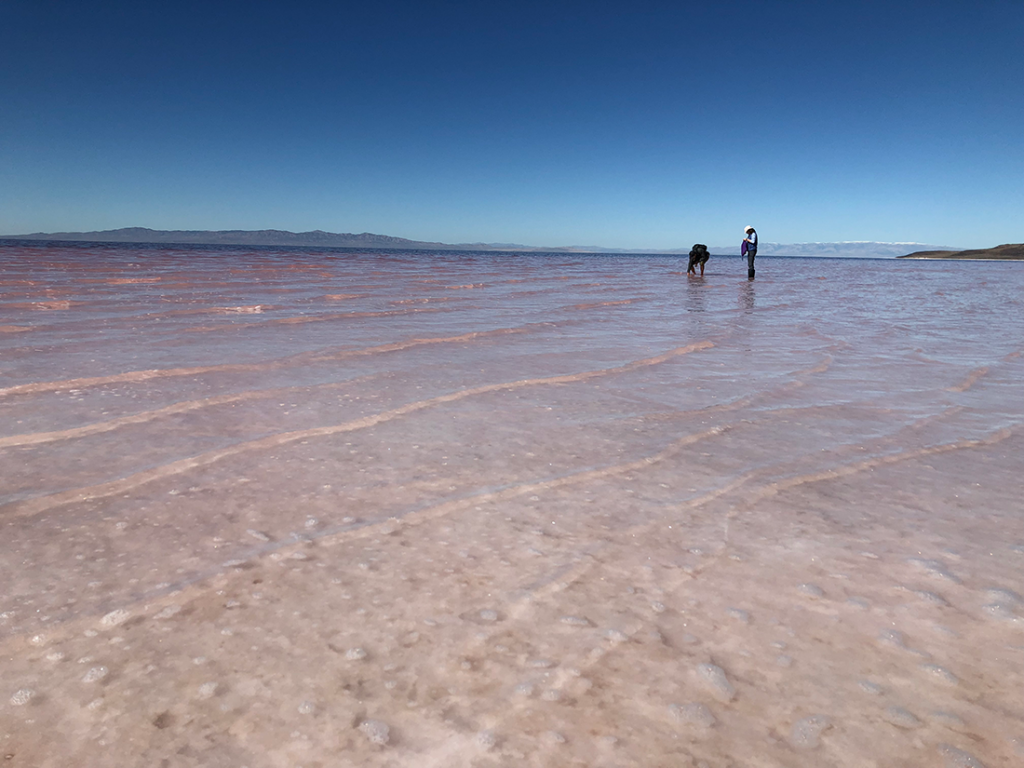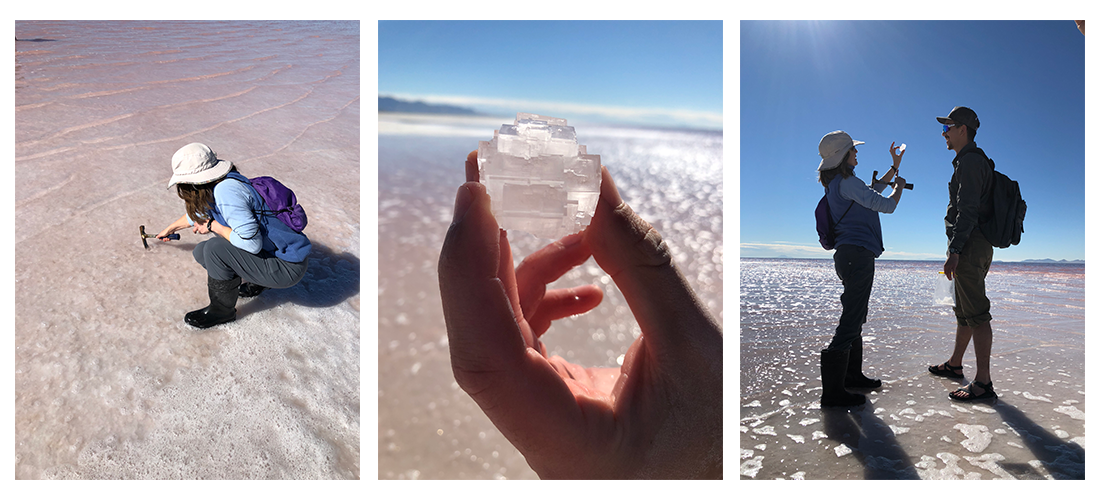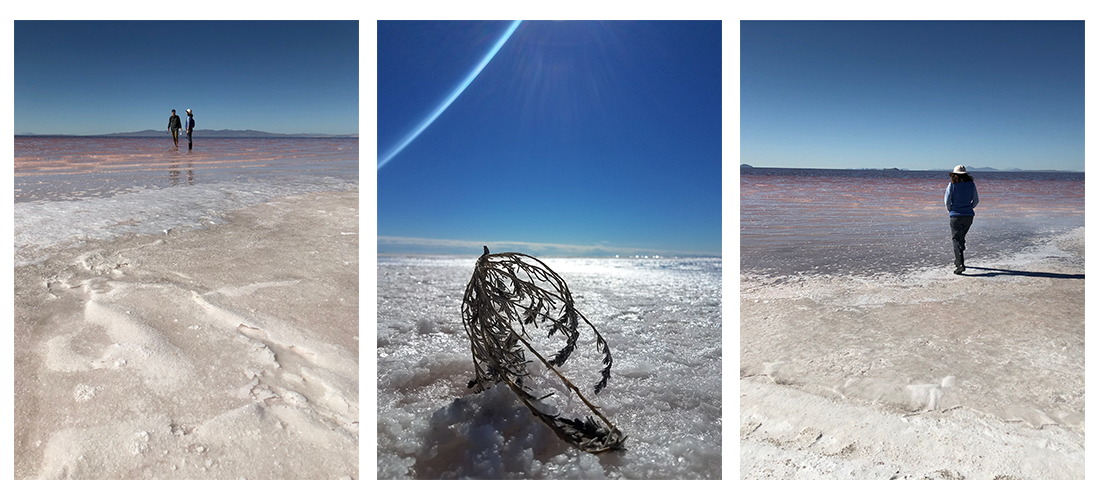
A Model For Life On Mars

Westminster researchers aid in determining the existence of traces of life on Mars
by Arikka Von (MSC ’15)
The shores of Great Salt Lake feel otherworldly: a motionless body of water is the backdrop against sand sparkling with salt crystals that are seemingly barren yet teeming with life. The lake is entirely Earthly, but the glistening crust of the lakebed resembles crusts on Mars so closely that scientists are using Great Salt Lake to address the question: is there life on Mars?
Bonnie Baxter, director of Westminster’s Great Salt Lake Institute (GSLI), is collaborating with NASA’s Jet Propulsion Lab (JPL) to study what salt can preserve over time. Her research shows that salt crystals at the lake trap tiny forms of life—biological footprints.
“We pick up salt crystals along the shores, and what we’ve found in our lab is that microorganisms can get trapped inside these crystals,” Bonnie says. “People who study salt biology have been reporting this for a number of years now. Even going back millions of years, you can find microorganisms or their molecules preserved.”
What about three-billion-year-old salt on another planet? If salt on Earth can hold onto biological molecules over time, could salt on Mars hold evidence that life was once in the planet’s salty lakes? The next Mars Exploration Rover Mission in 2020 will examine minerals on Mars, looking for the molecules of life stored inside. But NASA needs an analogous system on Earth to test its methods. JPL heard about the work Bonnie and her students were doing at Great Salt Lake and reached out for help.

“Folks from JPL come to Great Salt Lake to explore the salt with us and think about how it might compare to Mars’s salt deposits,” Bonnie explains. “My students and I have been growing microbes from our lake salt crystals. We may not find living cells on a dead planet like Mars, so JPL scientists are studying the ability of salt to retain molecules like DNA or lipids inside the salt crystals to see if they can image that from the outside.”
Rovers on Mars have already found minerals, including salt, in ancient, dried-up lakebeds. Mars lost its surface water and atmosphere more than three billion years ago—just as life was emerging on its neighbor, Earth.
“It is possible that microorganisms could have traveled between the two planets because we know space debris traveled between the planets. Both planets had atmosphere and standing water at that time,” Bonnie says. “Life evolved on Earth; we know that story. It is absolutely a great scientific question to ask if life also emerged on Mars.”
Bonnie’s students are involved in the research too, studying the types of microorganisms that grow out of salt crystals and evaluating the properties that would make them good models for life on Mars. If a microbe can live in the high salt and high UV radiation at Great Salt Lake, could something similar have once lived on Mars?
“I was pretty blown away because the first time you hear it, it’s really crazy, honestly. You don’t think that somehow Great Salt Lake can be a model for what’s happening on Mars,” says biology major Adrik Da Silva (’20).
Adrik is a Westminster junior and teaching assistant in Bonnie’s genetics class. He works with Bonnie to collect salt crystals at Great Salt Lake, then returns to campus to find out what’s inside them.
“I conduct the lab experiments: extracting the archaea (single-celled microorganisms) out of the salt or gypsum and putting them in growth media. The microorganisms will start dividing, and a colony with the same genetic makeup grows. I take that colony, isolate it, and then run a DNA sequence to figure out what the organism is,” Adrik explains.

Bonnie takes the salt crystals collected by students from Great Salt Lake to her collaborators at NASA. Scientists then examine the crystals using a special instrument that will be on the Mars 2020 rover.
“If they find life on Mars, then I would feel like I was part of something huge because it’s like alien life. That’s insane. I didn’t think I’d be a part of that as an undergraduate,” Adrik says.
When the next rover lands on Mars, Bonnie and her students will be following closely. Bonnie isn’t hoping for little green men on the red planet. “Some people ask, ‘Is there life on Mars?’ And maybe there was at one time and it is now gone,” she explains. “The question we are asking is, ‘Did life leave any traces on Mars?’”
About the Westminster Review
The Westminster Review is Westminster University’s bi-annual alumni magazine that is distributed to alumni and community members. Each issue aims to keep alumni updated on campus current events and highlights the accomplishments of current students, professors, and Westminster alum.
GET THE REVIEW IN PRINT Share Your Story Idea READ MORE WESTMINSTER STORIES